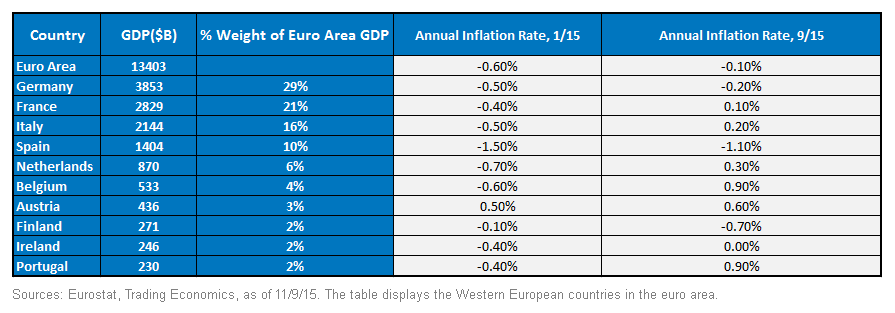For Mario Draghi and the ECB, Deflation Is a Moving Target


 Since January, Belgium has seen a 1.3 percentage point increase in its inflation rate. Yet Spain, a country that was experiencing severe deflation, has only reduced the rate of deflation by less than half a percentage point. Likewise, Finland has actually seen prices fall 0.6% since the start of European QE. So when the ECB shoots, what is it aiming for?
“The ECB’s definition of price stability makes clear that the focus of its monetary policy is on the euro area as a whole,” according to the ECB’s website. But in 2011, Fernanda Nechio of the Federal Reserve Bank of San Francisco found that by using the Taylor rule, “a policy guideline that generates recommendations for a monetary authority’s interest rate response to the paths of inflation and economic activity,” the euro area’s core countries and peripheral countries do not fall in line with the ECB’s one-size-fits-all target rate.1 Essentially, the pieces work when pulled together, but when viewed separately, they tend to fall short of the ECB’s target (especially in the case of the peripheral countries).
Currently, all the countries on this list are falling short of the “close to 2%” target. This makes the possibility of additional ECB action in December likely. The larger question will be how the ECB will react when a majority of its members are closing in on the target but many of the “peripheral” countries, such as Spain, are left far away from the bull’s eye. If history tends to repeat itself, it seems the ECB will continue to focus on the euro area as a whole and leave the less fortunate countries to fend for themselves.
Presently, the euro area as a whole is still far from its inflation goal. Even excluding the impact of falling food and energy prices, core inflation across the continent is only 1.1 percent.2 The euro has weakened in the last few weeks in response to Draghi’s public musings. Further euro weakness and additional credit easing in Europe would, in our view, be bullish for the local recovery now taking shape across the region. That could provide another leg up for the European equity rally, particularly for U.S. investors who make the effort to mitigate the impact of a depreciating euro to their stock portfolios.
1Fernanda Nechio, “Monetary Policy When One Size Does Not Fit All,” Federal Reserve Bank of San Francisco, 6/13/11.
2Source: Trading Economics.
Since January, Belgium has seen a 1.3 percentage point increase in its inflation rate. Yet Spain, a country that was experiencing severe deflation, has only reduced the rate of deflation by less than half a percentage point. Likewise, Finland has actually seen prices fall 0.6% since the start of European QE. So when the ECB shoots, what is it aiming for?
“The ECB’s definition of price stability makes clear that the focus of its monetary policy is on the euro area as a whole,” according to the ECB’s website. But in 2011, Fernanda Nechio of the Federal Reserve Bank of San Francisco found that by using the Taylor rule, “a policy guideline that generates recommendations for a monetary authority’s interest rate response to the paths of inflation and economic activity,” the euro area’s core countries and peripheral countries do not fall in line with the ECB’s one-size-fits-all target rate.1 Essentially, the pieces work when pulled together, but when viewed separately, they tend to fall short of the ECB’s target (especially in the case of the peripheral countries).
Currently, all the countries on this list are falling short of the “close to 2%” target. This makes the possibility of additional ECB action in December likely. The larger question will be how the ECB will react when a majority of its members are closing in on the target but many of the “peripheral” countries, such as Spain, are left far away from the bull’s eye. If history tends to repeat itself, it seems the ECB will continue to focus on the euro area as a whole and leave the less fortunate countries to fend for themselves.
Presently, the euro area as a whole is still far from its inflation goal. Even excluding the impact of falling food and energy prices, core inflation across the continent is only 1.1 percent.2 The euro has weakened in the last few weeks in response to Draghi’s public musings. Further euro weakness and additional credit easing in Europe would, in our view, be bullish for the local recovery now taking shape across the region. That could provide another leg up for the European equity rally, particularly for U.S. investors who make the effort to mitigate the impact of a depreciating euro to their stock portfolios.
1Fernanda Nechio, “Monetary Policy When One Size Does Not Fit All,” Federal Reserve Bank of San Francisco, 6/13/11.
2Source: Trading Economics.
Important Risks Related to this Article
Investments focused in Europe increase the impact of events and developments associated with the region, which can adversely affect performance.


